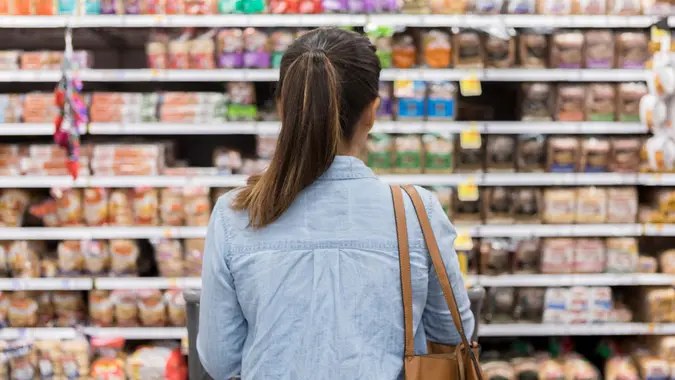Keeping your kitchen stocked is significantly more expensive than it was just a few years ago.
According to the latest data from the Consumer Price Index (CPI), the index for food at home increased by 0.3% in July and 3.6% over the last 12 months. Four of the six major grocery store food group indexes increased over the month. The U.S. Department of Agriculture Economic Research Service reported that food prices are expected to grow more slowly this year, and estimates food at home prices will increase by 4.9%.
While inflation is slowing down, there are several grocery items in particular that will likely experience price increases this fall. Here are grocery items with the biggest price increases.
1. Beef
Ground beef is over 20% more expensive than it was in 2020, reported Eat This, Not That! Prices are expected to rise throughout the summer and into the fall, and experts say we likely won’t see beef prices cooling within the next several years.
We could also see declines in beef production by more than two billion pounds next year, according to data from the USDA. This would be the biggest decline since 1979. The Wall Street Journal reported that cattle ranchers nationwide are shrinking their herds due to droughts and rising costs.
2. Oranges
Citrus harvests in Florida have been trending lower over the past two decades due to hurricane winds and disease, Eat This, Not That! reported. The cost of a gallon of orange juice has increased by 17.5% since early 2022, reaching $10 in some areas of the country.
Greening disease has also caused the fruit to taste bitter, so the $10 price tag may not be worth it.
“Prices are going to stay high, and demand is going to go down because consumers can’t afford it and may not like the taste,” Judy Ganes, head of commodities research firm J. Ganes Consulting, told the Washington Post.
3. Peaches
One of the country’s top peach producers is battling a low harvest this year because of weather conditions in Georgia. Jake Carter, owner of Southern Belle Farm, told Fox 5 Atlanta that they only have about a 40% crop this year. Lee Dickey, owner of Dickey Farms in Musella, Ga., explained to The Takeout that he expects peaches to cost 20% to 50% more this year.
4. Bread
The cost of one pound of white bread increased by more than 15% over the last year, according to the Bureau of Labor Statistics Mid-Atlantic Information Office. Prices for whole wheat also went up by nearly 11%. These sharp increases are largely from grain supply shortages imposed by the Russian invasion of Ukraine, ABC News reported. Ukraine is the world’s fifth-largest exporter of wheat.
5. Processed Fruits and Vegetables
Frozen vegetable prices jumped by more than 17% in June compared to the previous year, reported ABC News, and the cost of canned fruits increased by 8% over the same period. Canned vegetable prices also went up by more than 5%.
David Ortega, a food economist at Michigan State University, explained that these foods have resisted a cooldown of prices because they require a “long supply chain” as the global economy continues to recover from pandemic disruptions.
6. Olive Oil
Global olive oil prices have hit their highest level in 26 years, Eat This, Not That! noted. Droughts, heatwaves and water shortages in Spain, the world’s largest producer of olive oil, have destroyed crops. The country will only produce 680,000 tons of olive oil for the 2022-2023 season, much lower than the 1.5 million tons the previous season.
Dusan Kaljevic, CEO of Filippo Berio U.S, told Food & Wine that they expect a 30% to 50% price increase, depending on the type of oil.
7. Chocolate
Domestic chocolate prices have gone up 14% over the last year because of extreme weather patterns and crop disease. Eat This, Not That! reported that many major chocolate producers have raised prices, and data suggests prices will only continue to rise into the fall.

